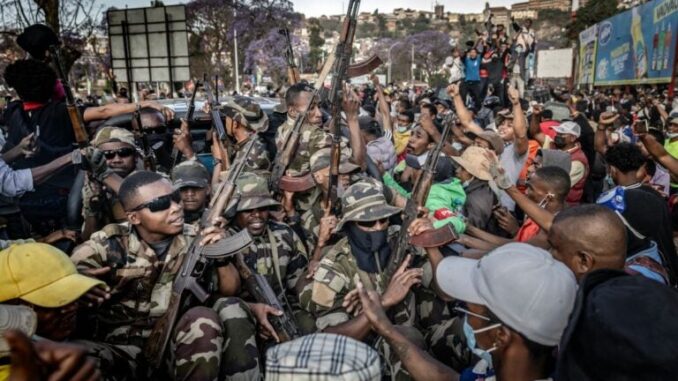
Groups of Madagascar soldiers joined thousands of protesters in the capital on Saturday after publicly declaring they would reject any orders to shoot demonstrators, AFP reporters confirmed.
The youth-led demonstrations in Antananarivo drew massive crowds in one of the largest gatherings since the protest movement began on September 25.
The rallies, initially triggered by power and water shortages, have evolved into a broader call for President Andry Rajoelina’s resignation.
Police had earlier used stun grenades and tear gas in an attempt to disperse the crowd around the Lake Anosy area, but soldiers soon arrived and were greeted with loud cheers from demonstrators waving Madagascar’s national flag.
At an earlier meeting in Soanierana, a district on the outskirts of the capital, the soldiers vowed not to take action against civilians.
“Let us join forces — military, gendarmes, and police — and refuse to be paid to shoot our brothers and sisters,”the soldiers said in a video circulating on social media.They further urged troops stationed at the airport to prevent aircraft from taking off and called on other units to disobey any command to open fire on protesters.
“Do not obey orders from your superiors. Point your weapons at those who order you to fire on your comrades,”the statement added.
Saturday’s demonstration was the largest in days, though it remains unclear how many soldiers have joined the dissent.
In 2009, soldiers from the same Soanierana base led a mutiny that helped bring President Rajoelina to power.
Meanwhile, the newly appointed Minister of Armed Forces, General Deramasinjaka Manantsoa Rakotoarivelo, appealed for calm, urging the troops to remain neutral.
“We call on our brothers who disagree with us to prioritise dialogue. The Malagasy army remains a mediator and the nation’s last line of defence,”he said during a press briefing.
The United Nations on Friday called on Malagasy authorities to refrain from the use of excessive force and to uphold citizens’ rights to free association and peaceful assembly.
According to the UN, at least 22 people have been killed since protests began on September 25, while President Rajoelina disputes that figure, claiming there were 12 confirmed deaths, all of whom he described as “looters and vandals.”
Although Rajoelina initially dismissed his entire cabinet in an attempt to calm tensions, he later appointed a military officer as prime minister and filled key government posts with security chiefs, declaring that the country “no longer needs disturbances.”
Among the world’s poorest nations, Madagascar has a long history of political unrest, with military-backed uprisings dating back to independence in 1960.
Rajoelina, who first rose to power through such an uprising in 2009, was re-elected in 2018 and 2023 in elections boycotted by the opposition.
AFP

Leave a Reply